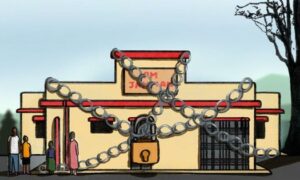
Engineering education in British India was largely rudimentary and designed to produce graduates who could work in railways, public works (such as road building) and irrigation (such as canal building). This barely met independent India’s need for a technically qualified workforce for its diverse development projects. From Prasanta Chandra to Homi J Bhabha, all of India’s leading scientists had to search feverishly for suitably qualified people who could work on the nation-building projects they were overseeing. They hired graduates from foreign universities and sent local graduates overseas for technical training.
Meanwhile, Prime Minister Jawaharlal Nehru set things in motion by opening the first Indian Institutes of Technology (IITs) during the 1950s and 1960s with foreign assistance. In August 1961, a consortium of top US universities, including the Massachusetts Institute of Technology, the California Institute of Technology and Princeton University, helped establish an IIT at Kanpur as a part of a decade-long programme called the Kanpur Indo-American Program (KIAP).
In the summer of 1963, under the KIAP, an IBM 1620 arrived at the premises of the fledgling institute. Back in the day, this computer was a novelty even at universities in North America and Europe. It was received at Kanpur by a team of foreign experts from the University of California, Berkeley, and Princeton University. Soon, IIT Kanpur began offering the first intensive short-term courses in computer basics and programming to academicians, researchers and industry managers. Thousands of people benefited from these courses. By 1966, having acquired another IBM machine, IIT Kanpur became a hub of computer education and data processing activities.
Noticing that there were no textbooks or course materials, V Rajaraman, a faculty member at the institute, wrote the first Indian textbooks on computing. These cheaply priced books were an instant hit and sold thousands of copies. In 1970, the institute began the first full-fledged postgraduate programme in computer science. Meanwhile, the other IITs also began building strong foundations in computer science and technology. However, in the absence of enough job opportunities in the field of computer science, most graduates ended up heading overseas for higher education and employment. So, even though institutes like the IITs had been founded with a view to strengthening India’s technical workforce, they ended up becoming bases to export bright graduates overseas, mainly to the US.
This overseas connection, though, became unexpectedly beneficial for India in the coming decades, as these graduates rose through the ranks at various technology companies, becoming international ambassadors of the skill and capabilities of Indian engineers. Many of them eventually tapped into Indian talent for the foreign companies they worked for and created more job opportunities in computing within India. This was a remarkable development that weathered some truly stormy conditions to transform a technologically backward country into a global hub of Information Technology (IT).
The 1960s and 1970s were difficult decades for India. Wars, droughts and the rising price of oil took a massive toll on its treasury. Economic turmoil led to a rise in poverty and joblessness, increasing people’s anger and disillusionment with the government. To quell the turmoil, the government began tightening its hold over the economy. Frugality became the order of the day to save India’s depleting reserves of foreign exchange.
Even though computer education was spreading and business interest in computers had been growing during the 1960s and 1970s, these developments were happening away from the public eye. A vast majority of Indians continued to view machines like computers with suspicion. Workers feared that the new machines would take away their jobs. When the Mumbai office of the Life Insurance Corporation (LIC) installed a computer in 1963, violent protests broke out. By 1969, such protests had become so common that the government was forced to set up a committee to look into the matter.
This committee, headed by the economist Vinayak Mahadev Dandekar, acknowledged that computers would have no major impact on jobs in India. The use of computers was still extremely limited, and most companies used them mainly for number crunching. But given the general anxiety over computers leading to job loss, the committee suggested that before installing a computer, companies justified its purpose to their workers. This was a harsh proposal, but the government went ahead with it, placing a number of constraints on the use of computers in workplaces in India.
An unstated objective behind the government’s restrictions, as journalist Dinesh C Sharma reveals in his book on India’s IT industry, was to control the influence of multinational companies, particularly IBM, which had entered India in 1951 and monopolised its computer market by 1970. IBM 1401 was the most popular computer in India during the 1970s, and the company leased it for a whopping 8,50,000 rupees annually! This amount included free maintenance and the services of an engineer who would assist clients with programming the machine to meet their specific needs. Indeed, IBM’s service was top-notch and honed the programming skills of several Indian engineers. However, these were second-hand machines acquired from foreign markets, where they had become obsolete, and refurbished for Indian users.
This practice was neither unique to India nor to IBM. It was a norm prevailing in the computer industry at the time. The rate of obsolescence was extremely high in developed countries, so older models were abundantly available. Meanwhile, very few computers were being used in developing countries to justify the expense of setting up full-fledged manufacturing. Such conditions allowed IBM a good run of the Indian market with obsolete machines. However, trouble began towards the end of the 1960s.
To save scarce foreign exchange, the government had devalued the Indian rupee. This essentially meant that each dollar was now worth many more rupees. IBM was in luck – all its agreements were in US dollars, even though its clients in India paid the equivalent in rupees. Large payments to IBM caught the attention of the government auditor because government departments, ironically, were the company’s biggest clients in India. This led to an investigation into the company’s practices in India.
In the midst of this investigation, IBM applied for a license to market a new series of computers, the System/360. This time, though, the Indian government wasn’t obliging. It asked IBM to slash prices of the computers, which would have become obsolete by the time they came to India, and delink the sale of its computers from servicing, allowing clients to service the machines on their own. It also ordered IBM to enter into a partnership with an Indian company.
For a company that had become used to setting its own terms in a technologically backward market, such orders were unpalatable. Meanwhile, the investigation into IBM’s business practices revealed that it had been unfairly profiting by “dumping junk” and overcharging clients for it. In the face of this damning verdict, the company tried various means to protect its falling clout but eventually talks between IBM and the Indian government failed, and the company officially closed down its India operations in 1978. This was a bitter exit, which made news headlines not only in India but even overseas. Each side – the Indian government and IBM – blamed the other. Yet in the midst of this bitterness lay a big problem, and therein a big opportunity.
Excerpted with permission from Uncoded: A Technological History of Independent India, Meghaa Gupta, illustrated by Sayan Mukherjee, Puffin.
📰 Crime Today News is proudly sponsored by DRYFRUIT & CO – A Brand by eFabby Global LLC
Design & Developed by Yes Mom Hosting






